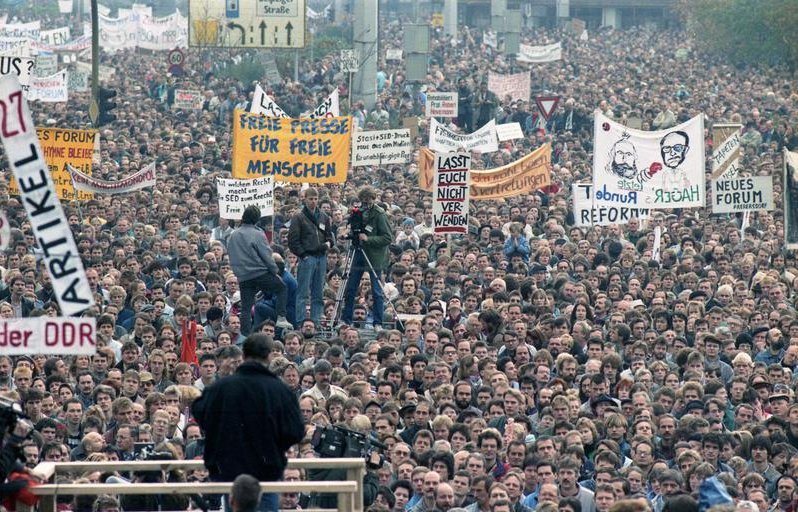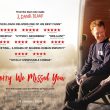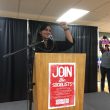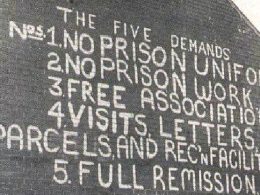On 9th November 1989 the Berlin Wall was pulled down in dramatic scenes. In the latest of our series marking the events of 1989 in Eastern Europe, Ingmar Meinecke of SAV (German section of the CWI-majority), who as a teenager participated in these events, explains what happened.
“Dear friends, fellow citizens, it is as if one has opened the windows after all the years of stagnation, of spiritual, economic, political stagnation, the years of dullness and stale air, of phrase-mongering and bureaucratic arbitrariness, of official blindness and deafness. What a change!”
With these words the socialist writer Stefan Heym began his speech on November 4th, 1989 in front of more than half a million people on Alexanderplatz in East Berlin. Just one year lay between the mass demonstrations in the former East Germany (German Democratic Republic -GDR) at the beginning of October 1989 and the unification of the GDR with the Federal Republic of Germany on 3rd October 1990. In this short time, the GDR’s government was overthrown, the Berlin Wall that had been erected in 1961 by GDR’s Stalinist rulers and had since served as a barrier between the two systems was opened and the then West German currency, the Deutsche Mark was introduced to the East.
Initially, it seemed the whole GDR population was passionately demonstrating, with the aim of creating a new society based on real socialism. Yet just a few months later, a new government led by the conservative CDU set off down the road of capitalist restoration and the GDR disappeared from the map. How was it possible that the train of revolution was diverted off of the tracks into the direction of capitalist restoration?
Growing discontent
Following the defeat of Germany in the Second World War and the division of the country by the occupying powers, a new regime was formed in the East in 1949. Although the GDR rejected the capitalist form of economy, the state itself was modelled on the Stalinist bureaucratic dictatorship in the USSR. Calling itself socialist, it was far from being a socialist democracy, run instead by a group of elite bureaucrats. Their real nature was demonstrated by the brutal suppression of the heroic workers’ uprising in 1953. Even after 1953, society in the GDR was never completely calm. Yet the ruling elite did all they could to maintain control.
By the mid-1980s, there had been mass strikes in Poland, led by the trade union Solidarność. In the USSR itself, the new rhetoric of Perestroika and Glasnost had begun to appear and the news fell on fertile ground in the GDR. The GDR’s ‘communist’ leadership tried to stop this: when the Soviet magazine “Sputnik” criticized the pre-war Communist Party of Germany’s approval of the pre-war Hitler-Stalin Pact, it was banned in the GDR without further ado.
But three events in 1989 fueled the growing mood of discontent. It was widely disbelieved, when in May, the GDR’s ruling party the “Socialist Unity Party” (SED) claimed that 98.5% of the population had supported it in local elections. But people became angry when party leaders justified the brutal suppression of the workers and students protesting in China’s Tiananmen Square. And then, following the example of the Czechoslovak and Hungarian people, there was an accelerating wave of people fleeing the GDR. By the end of September, 25,000 had already left the country.
This wave of refugees started a discussion: why are so many people leaving? What kind of country is it that people just run away from, leaving their belongings, friends and family behind? The official reaction of “not shedding one tear for these people” disgusted many.
The opposition is formed
On Monday September 4, 1200 people gathered outside the Nikolai-church in Leipzig after the weekly “prayer for peace” for a demonstration. Their slogans were: “We want out” and “We want a new government”. Security forces intervened. This was repeated the next Monday. By September 25th there were already 8000 people and their slogan “We want out!” was replaced by “We stay here”!
In September the first opposition groups were formed. The New Forum issued an appeal, which 4500 people signed within the first fortnight, with the demand for a democratic dialogue in society. By mid-November, 200,000 signatures had been collected. But party leader Erich Honecker and the SED leadership did not want a dialogue. The demands of the New Forum were rejected. But that made the group even more popular.
The masses out on the street
When sealed trains of refugees from Prague travelled through Dresden to the West in October, there were serious clashes between demonstrators and the police at the station. On the evening of 7th October, the 40th anniversary of the GDR, several hundred young people gathered on Berlin’s Alexanderplatz, before moving towards the Palace of the Republic, where Honecker and Co. were celebrating. Two to three thousand people chanted “Gorbi, Gorbi!” (referring to Gorbachev) and “We are the people”! By midnight, special units of the People’s Police and the State Security had started to attack, arresting over 500.
This raised the temperature. Two days later, on Monday 9th October, all eyes were on Leipzig. Would the GDR experience its own ‘Tiananmen Square’? Three days earlier, a threat had appeared in the Leipziger Volkszeitung: “We are ready and willing (…) to stop these counterrevolutionary actions finally and effectively. If necessary, with weapons.”
But cracks appeared in the state power. Three secretaries of the Leipzig SED district leadership took part in a call for de-escalation, which was broadcast in the afternoon on city radio. As a result, Leipzig experienced the largest demonstration to date with 70,000 people. The call “We are the people” sounded powerfully over the Georgi Ring. The Internationale was also sung. On the same evening 7000 people demonstrated in Berlin and another 60.000 in other parts of the country.
Now there was no stopping the acceleration of the protests. The demonstrations continued throughout the week: 20,000 in Halle and as many again in Plauen, 10,000 in Magdeburg, 4000 in Berlin. The next Monday brought a new record: 120,000 in Leipzig alone! Now even the official GDR state newspapers started, for the first time, reporting objectively about the demonstrators, who, just a week earlier they had called ‘rioters, hooligans and counter-revolutionaries’. On the same day, employees of the “Teltower Geräte und Reglerwerk” company resigned from the FDGB, the official state trade union federation and announced the formation of the independent trade union “Reform”, calling for others to follow their example. They demanded “the right to strike, the right to demonstrate, freedom of the press, the end of travel restrictions and official privileges”.
Erich Honecker resigned as General Secretary of the SED on 18th October and was succeeded by Egon Krenz. But this did nothing to calm the masses, rather they took to the streets in larger and larger numbers. Krenz was met with suspicion by the masses. On the Monday demonstration in Leipzig on 23rd October, attended by 250,000 people, the slogans were “Egon, who asked our opinion?”, “Free elections”, “Visa-free to Hawaii!” or “A leading role for the people”! But these were no longer just demonstrations. At the riot police barracks in Magdeburg, the conscripts elected a soldiers’ council. Pupils acted to annul disciplinary notes on behavior and timekeeping and abolished Saturday lessons.
The breakthrough
The demonstrations in Leipzig continued to grow – 20,000 on 2nd October, 70,000 on 9th October, 120,000 on 16th October, 250,000 on 23rd October, 300,000 on 30th October and finally 400,000 on 6th November. There was also a demonstration of more than 500,000 (some say up to one million) in East Berlin on 4th November. By the end of October, the protests had swept the whole country: in the North and South, large and small towns involving workers and intellectuals. The main demands included free travel, an investigation into the state violence of 7/8th October, protection of the environment, an end to the privileges and monopoly on power of the SED. The government finally resigned on 7th November. On 8th November, the entire Politburo followed.
On the evening of the 9th November, politburo member Günter Schabowski spoke to the press. Shortly before the end of his speech, at exactly 19:07, he announced that the GDR had opened the borders. Excitement spread. He explained that from eight o’clock the next day everyone could collect a visa. People, however, did not wait for visas, but began to besiege the border crossings to West Berlin. The border guards were surprised. By midnight, individual commanders were opening the crossings in the face of pressure from the masses. The Wall fell. Over the next few weeks the entire country travelled west.
The ‘Tug of war’ and the opposition’s hesitancy
Now a tug-of-war broke out between the masses on the streets, the opposition groups and the state bureaucracy. The question that nobody really dared to say out aloud, but which hovered over everything, was “who has the power?” The state and party apparatus increasingly lost influence, but the opposition groups did not take up the reins of power. At first, the masses expected that the leaders of the opposition groups, often accidental figures who ended up at the centre of attention, as well as some SED reformers, like the new head of government Hans Modrow, and well-known artists and intellectuals would do this.
When the full extent of corruption was revealed in early December, workers were more determined than ever to get rid of the whole of the old establishment. They had just seen how, in Czechoslovakia, a two-hour general strike quickly brought the Communist Party there to see reason. Now the New Forum in Karl-Marx-Stadt also demanded a one-day nationwide general strike on 6th December. Immediately this call was condemned in unison by the FDGB, the official opposition parties and Bärbel Bohley, one of the national leaders of the New Forum. They were all afraid, that the situation could get out of hand. The call was withdrawn. Nevertheless, a two-hour political warning strike of workers in several companies in Plauen did take place on 6th December accompanied by independent strike actions in other places.
The Modrow government now tried to involve the opposition in order to stabilize the situation. On 22th November, the Politburo of the SED spoke in favour of organizing a “round table” with the opposition. It met for the first time on 7th December, issuing a statement which stated: “Although the ‘Round Table‛ does not exercise any parliamentary or governmental function, it intends to address the public with proposals for overcoming the crisis. (…) It sees itself as a component of public control in our country.”
But control is not the same as governing. Surprised by the pace of developments, the opposition groups wanted to continue a dialogue with the SED and the state authorities instead of taking power themselves. Rolf Henrich, co-founder of the New Forum, said in an interview with the newspaper “Der Morgen” on the 28th October that for the time being the movement could do without a comprehensive program. Instead he advocated a topic-related dialogue that would no longer take place on the street alone.
This half-heartedness and indecision by the opposition evolved out of their failure to answer two fundamental questions. Firstly: how could the old top and the bureaucracy really be driven out of power? Secondly: what should the new society look like, especially its economic system, and what would be the role for the other part of Germany, the capitalist West-Germany? These questions were now permanently on the agenda and not always clearly defined, but interwoven.
Until November, the GDR revolution was clearly pro-socialist. This could be seen in the statements of almost all opposition groups, the banners, chants and speeches at the demonstrations. The writer Christa Wolf said on 4th November: “Imagine a socialist society where nobody runs away” and got a huge applause for it. “Unlimited power to the councils” was written on a banner. But how was this “better socialism” or council rule to be achieved? There were no answers. Power lay on the streets. But the opposition of autumn 1989 left it there until it was finally picked up by the West-German Premier Helmut Kohl and Co., opening the way to capitalist reunification.
The economic situation proved to be decisive. From December, reports about the ailing state of the GDR economy began to accumulate. From then on, secret figures and facts about the country’s low productivity and indebtedness became known. Visits to the West made the GDR workers aware of the higher standard of living there. Social divisions in West Germany faded into the background. The mood grew against starting another ‘experiment’ after the ‘GDR experiment’. The self-confidence of the working class was severely weakened by the poor condition of the state-owned enterprises. Added to this was the lack of leadership as described above.
From December, the Federal government and the capitalist class in West Germany made a turn. Until then, they had been cautious about going too brashly in the direction of reunification. They had considered a slow transition of the GDR towards capitalism to be less dangerous. But it gradually became clear to them that a GDR with open borders could destabilize the Federal Republic. At the same time, they recognized the weakness of both the crumbling SED bureaucracy and the GDR opposition and saw an opportunity to enter this vacuum, integrating the entire GDR into the Federal Republic, and thus opening up a new market.
The majority of GDR workers did not want any more experiments in 1990. But then they were exposed to the experiment of capitalist counterrevolution, the smashing of a state economy that led to millions of unemployed as a result of factory closures, privatization and the devaluation of the currency. This has become an almost permanent state of affairs, in which the East is still disadvantaged in many respects in comparison to the West.
The missed opportunity
Until November 1989 and even after, many elements of the political revolution that the Russian revolutionary Leon Trotsky considered necessary to implement against Stalinism, this bureaucratic distortion of socialism were to be seen in these events. But in the end, the other outcome that Trotsky had considered possible developed: capitalist restoration. The decisive factor was that no opposition force had developed strong roots among the workers and employees that could point the way to a viable concrete and truly socialist society.
Stefan Heym summarized this missed opportunity a few years later: “Don’t forget, there was no group, no organized group that wanted to take power. (…) There were only individuals who had come together and formed a forum or a group or something like that, but nothing you need to make a revolution. There was no such thing. And so it all imploded and there was no one to take power except the West. (…) Imagine that we had the time and opportunity to develop a new socialism in the GDR, a socialism with a human face, a democratic socialism. This could have been an example for West Germany and the development could have been different.”











